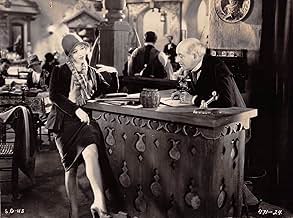Ajouter une intrigue dans votre langueA homeless and destitute violinist joins a combo to bring it success, but has problems with her love life.A homeless and destitute violinist joins a combo to bring it success, but has problems with her love life.A homeless and destitute violinist joins a combo to bring it success, but has problems with her love life.
Gus Arnheim and His Cocoanut Grove Ambassadors
- Musical Ensemble at Club Joyzelle
- (as Gus Arnheim and his Ambassadors)
André Cheron
- Aide to Prince Nicholaus
- (non crédité)
Cimini Male Chorus
- Off-Screen Vocal Ensemble
- (non crédité)
June Clyde
- Hot Blonde at McGregor's
- (non crédité)
Art Fleming
- Drummer in Gus Arnheim's Orchestra
- (non crédité)
Nelson Hall
- Guitarist in Gus Arnheim's Orchestra
- (non crédité)
Eddie Kane
- Mr. Gilman
- (non crédité)
Raymond Maurel
- Vocalist at Little Aregon
- (non crédité)
Commentaire à la une
John Harron, Jack Oakie, Ned Sparks -- who actually smiles in this movie, a terrifying sight -- and Guy Buccola are a jazz quartet who aren't doing well. Coming home with groceries, Harron runs into starving Betty Compson, and invites her to join them for dinner. When she claims she plays the violin, they lend her one.... and she's good. Soon they are making a living, playing for restaurateur Joseph Cawthorn, when prince Ivan Lebedeff comes to the restaurant, and recognizes Miss Compson; this gets Harron jealous.
Miss Compson is terrific, of course; her performance aided by her first job in show business, as a violinist, but this first production by RKO, with a score by Oscar Levant, is cannily directed by Wesley Ruggles. Over at First National, all the musical numbers seemed to be shot long distance on a proscenium stage that would make the one at Radio City seem a shoebox. Ruggles shoots them naturally: a jam session in the apartment, a performance or two in the restaurant, accented by a moving camera, while elements of the Gus Arnhem Orchestra did the actual playing, and only the last number on a big stage.
In the end, it's a well produced minor semi-musical that succeeds by the simple expedient of doing some things very right, and nothing wrong. That may seem like small potatoes, but is actually unusual. As the first movie produced, if not released by RKO, it was a major hit, and deserved to be. If it has fallen into desuetude, it is because the vast majority of 1929 musicals are properly held in low esteem -- First National, I'm looking at you! -- and this one is unfairly lumped in with them.
Miss Compson is terrific, of course; her performance aided by her first job in show business, as a violinist, but this first production by RKO, with a score by Oscar Levant, is cannily directed by Wesley Ruggles. Over at First National, all the musical numbers seemed to be shot long distance on a proscenium stage that would make the one at Radio City seem a shoebox. Ruggles shoots them naturally: a jam session in the apartment, a performance or two in the restaurant, accented by a moving camera, while elements of the Gus Arnhem Orchestra did the actual playing, and only the last number on a big stage.
In the end, it's a well produced minor semi-musical that succeeds by the simple expedient of doing some things very right, and nothing wrong. That may seem like small potatoes, but is actually unusual. As the first movie produced, if not released by RKO, it was a major hit, and deserved to be. If it has fallen into desuetude, it is because the vast majority of 1929 musicals are properly held in low esteem -- First National, I'm looking at you! -- and this one is unfairly lumped in with them.
Histoire
Le saviez-vous
- AnecdotesPromotional material claimed Betty Compson was an accomplished violinist and was playing live in her musical scenes, but, in actuality, her playing was mimed to previously recorded violin solos by off screen Russ Columbo who also appears on screen as an uncredited member of Gus Arnheim's Orchestra. This information was later revealed by the music's composer, Oscar Levant. Compson did learn to play the violin in her youth and played professionally in theaters and vaudeville since the age of 16. So, her bow movements and fingering appear authentic. Her character in Inside the Lines (1930) also plays the violin.
- Citations
Joe Spring: Well, seeing as you met my two boyfriends here, Summer and Winter, I'd like to introduce myself. I'm Joe Spring. The star of this band. And that slug on your left, there, being too ignorant to introduce himself, I'd just like to tell you that that's Mike Fall, the original fall guy.
Frederika Joyzelle: Oh, I know you boys. You are the Four Seasons.
- ConnexionsVersion of Adieu Paris, bonjour New-York (1936)
- Bandes originalesBroken Up Tune
(1929) (uncredited)
Music by Oscar Levant
Lyrics by Sidney Clare
Performed by Doris Eaton and the Radio Pictures Beauty Chorus
Meilleurs choix
Connectez-vous pour évaluer et suivre la liste de favoris afin de recevoir des recommandations personnalisées
Détails
- Date de sortie
- Pays d’origine
- Langue
- Aussi connu sous le nom de
- Street Girl
- Lieux de tournage
- Société de production
- Voir plus de crédits d'entreprise sur IMDbPro
Box-office
- Budget
- 211 000 $US (estimé)
- Durée1 heure 27 minutes
- Couleur
- Rapport de forme
- 1.20 : 1
Contribuer à cette page
Suggérer une modification ou ajouter du contenu manquant





























